#solar components
Explore tagged Tumblr posts
Text

#solar#solarpower#solar energy#solar panels#solar inverter#solar Batteries#Heatpump#solar lights#solar components
1 note
·
View note
Text
Electronics Components #components #electronics #engineering #electrical #arduino #electronic #innovation #design #robotics #electroniccomponents #raspberry #technology #manufacturing #industrial #gaming #school #learningbydoing #solar #bahrain #pc #pcb #budaiya #muhharaq #manama #engineeringforkids #saar #riffa #makersgonnamake #isatown #summerprogram
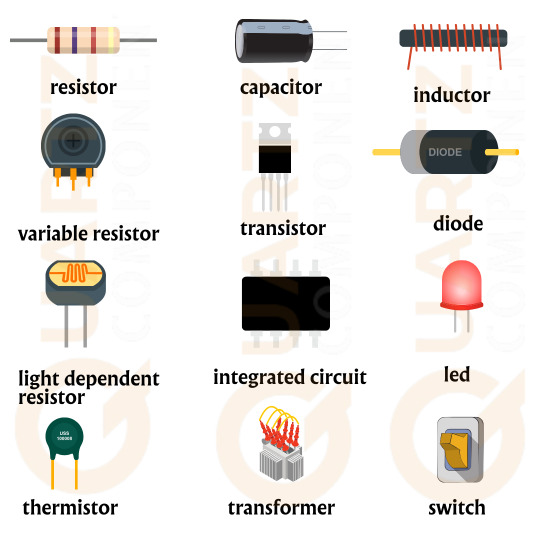
#Electronics Components#components#electronics#engineering#electrical#arduino#electronic#innovation#design#robotics#electroniccomponents#raspberry#technology#manufacturing#industrial#gaming#school#learningbydoing#solar#bahrain#pc#pcb#budaiya#muhharaq#manama#engineeringforkids#saar#riffa#makersgonnamake#isatown
13 notes
·
View notes
Text
i NEED to get weirded about tsams. i need to draw it with more weirdly religious themes. i need to draw it with more grief. i need to draw it with more wires and machinery. i need to incite the feeling of bright angels and the unfathomable divine. i need to incite the feeling of sand between your fingers and a heavy weight in your heart. i need to incite the feeling of fragility and looking at something you're not truly supposed to see. i NEED TO GET WEIRDER ABOUT THIS SHOW!!!!!
#xero says things#ITS SO HARD TO DO BC I'M A PERFECTIONIST BUT I NEED TO DO IT REGARDLESS#I NEED TO BE LESS SCARED OF BEING WEIRD 'BADLY' SO I CAN EVOLVE INTO THE KIND OF WEIRD I STRIVE TO BE#the path to drawing a tarot card-esque picture of lord eclipse wrapped around a praying (and crying) sunvant is first drawing weird shapes-#-and bad anatomy. the path to drawing solar missing his sun is first drawing awkward poses and slightly off expressions. the path to-#-drawing lunar with all their internals exposed is first drawing kinda boring oversimplified wires and components.#i WILL learn and i WILL get weirder. amen
12 notes
·
View notes
Text

here's a concept for a fusion thing ig.. they're completely batshit and exist only to annoy the everloving hell out of the jack pack
#it's rough as fuck and that grates at me (i have a compulsion to COMPLETE things)#not putting this in the main tags. it's very au-y and situational and all of that cl-- codswallop.#they're also actually fucking tall (like i think around 6'11”-7'1”????)#i don't actually know where this'll lead#but i'm thinking. canon divergence around the time shadowtrap gets released#lots of fuckery and then they fucking MELT together and out twirls this asshat.#imagine if the eclipse in deck 13.5 was like a lunar variant. this - by default - would be the solar variant#they're half their own person and two respective quarters of clap and shady. it wants to stay fused (and so does shadowtrap. at first)#but they're also UNSTABLE AS HELL™ and anything that can go wrong for the vault hunters 99.9% of the time WILL GO SO VERRRRRY WRONG#their components are also kinda amplified here!#if claptrap was annoying; he's insufferably infuriating. if shadowtrap is vengeful; they're insanely spiteful.#and they KNOW how the other five treated clap like shit. in retaliation he raises absolute hell and they have to bob and weave around every#little obstacle he sets down.#the ONLY things setting them back from breaking out are their components trying to up and split#| [ aaaaanddddd tag spam break!! ] |#i might tag this tho....#/ fusion!au#- gijinkatrap#<- although it's not exclusively a gijinka au! i might do a “canon” ver. soon!!#- velveteen pen-scribblings ]
9 notes
·
View notes
Text
Design and Structure of the ISS (International Space Station)
Explore the detailed Design and Structure of the ISS (International Space Station). Learn about its components and modules. Discover its solar arrays, truss systems, robotic arms, and life-support technology. 🛰️Design and Structure of the ISS (International Space Station) The International Space Station (ISS) is a triumph of modern engineering. It combines decades of knowledge, expertise, and…

View On WordPress
#International Space Station modules#ISS design#ISS engineering#ISS layout#ISS pressurized modules#ISS robotic arms#ISS solar panels#ISS structure#ISS truss system#space architecture#space station components
0 notes
Text
What is a Solar Flood Light?
A solar flood light is an energy-efficient lighting solution that harnesses solar power to illuminate large outdoor areas. These lights are equipped with solar panels, rechargeable batteries, and high-intensity LED bulbs, making them an eco-friendly and cost-effective alternative to traditional floodlights powered by electricity. Solar flood lights are widely used for security, outdoor events, and aesthetic lighting.
Components of a Solar Flood Light
1. Solar Panel: The solar panel captures sunlight and converts it into electrical energy. Panels can vary in size and efficiency, with monocrystalline and polycrystalline panels being the most common types.
2. Rechargeable Battery: The energy generated by the solar panel is stored in a built-in rechargeable battery, usually lithium-ion or lithium phosphate. This ensures the light can operate during nighttime or in cloudy conditions.
3. LED Bulbs: Light-emitting diodes (LEDs) are used for illumination. They are energy-efficient, long-lasting, and provide bright, focused light.
4. Control System: Solar flood lights often include features like motion sensors, light sensors, and timers to optimize energy usage. The control system ensures the light turns on automatically at dusk and off at dawn or adjusts brightness as needed.
5. Housing and Mounting Hardware: The housing protects the internal components from weather elements, and the mounting hardware allows for easy installation on walls, poles, or ground stakes.
A 30-watt street light is an energy-efficient lighting solution, ideal for illuminating roads, pathways, and public spaces with bright, reliable light.

Benefits of Solar Flood Lights
1. Energy Efficiency: Solar flood lights rely on renewable energy from the sun, reducing electricity consumption and utility bills.
2. Environmentally Friendly: Since they operate on solar power, these lights reduce carbon emissions, contributing to a greener planet.
3. Cost-Effective: Although the initial investment may be higher, solar flood lights eliminate ongoing energy costs and require minimal maintenance.
4. Easy Installation: With no need for wiring or access to an electrical grid, solar flood lights can be installed virtually anywhere.
5. Enhanced Security: Their bright illumination and optional motion-sensing features make them ideal for deterring intruders and enhancing safety.
6. Weather-Resistant: Designed to withstand outdoor conditions, solar flood lights are typically waterproof and durable, ensuring long-term reliability.
A solar light lithium battery stores energy from solar panels, providing long-lasting, efficient power for reliable, eco-friendly outdoor lighting solutions.
Applications of Solar Flood Lights
1. Home Security: Installed in driveways, backyards, or entrances, solar flood lights provide illumination for enhanced safety and deter potential intruders.
2. Commercial Spaces: Businesses use solar flood lights to illuminate parking lots, signage, and building exteriors.
3. Public Areas: Parks, streets, and community spaces often utilize solar flood lights to enhance visibility and safety.
4. Events and Decorations: These lights are perfect for outdoor gatherings, highlighting landscapes, or adding decorative lighting.
5. Rural and Remote Areas: In regions without reliable access to electricity, solar flood lights offer a practical and sustainable lighting solution.
Solar gate lights are eco-friendly lighting fixtures that use solar energy, enhancing entrance aesthetics and security while eliminating electricity costs.
Key Features to Consider When Choosing a Solar Flood Light
1. Brightness: Measured in lumens, the brightness of the light should match the area you want to illuminate.
2. Battery Capacity: A larger battery ensures longer operating times, even during cloudy days.
3. Solar Panel Efficiency: Higher efficiency panels generate more energy, even in low sunlight conditions.
4. Durability: Look for weatherproof and sturdy materials, such as aluminium or high-grade plastic.
5. Smart Features: Motion sensors, remote controls, and adjustable brightness levels enhance usability.
Solar garden lights are decorative, eco-friendly fixtures powered by sunlight, perfect for enhancing outdoor spaces with sustainable and cost-effective illumination.
Conclusion
Solar flood lights are a versatile and sustainable lighting solution for various applications. By harnessing the power of the sun, they reduce energy consumption, lower costs, and promote environmental sustainability. With their durability, efficiency, and ease of installation, solar floodlights are an excellent choice for anyone seeking reliable outdoor lighting. Solar street lights are energy-efficient outdoor lighting solutions powered by sunlight, offering sustainable, cost-effective illumination for roads, pathways, and public spaces.
#Solar Flood Light#Solar flood light outdoor#Solar flood light price#Solar flood lamp#solar light#Applications of Solar Flood Lights#Benefits of Solar Flood Lights#Components of a Solar Flood Light
1 note
·
View note
Text
Amphenol Solar Connector
The Amphenol Solar Connector is a high-quality, durable connector designed specifically for photovoltaic (PV) solar systems. Known for reliability and robust performance, these connectors provide secure, weather-resistant connections between solar panels, inverters, and other system components. The Amphenol Solar Connector is an industry-leading solution designed to deliver dependable connections for photovoltaic (PV) systems, making it ideal for solar energy applications in residential, commercial, and industrial setups.
0 notes
Text
Other examples of how the components of tropospheric air depend on location including over the open ocean, over large continental areas, urban areas, the tropics, and the Arctic are given in Table 2.2.

"Environmental Chemistry: A Global Perspective", 4e - Gary W. VanLoon & Stephen J. Duffy
#book quotes#environmental chemistry#nonfiction#textbook#components#troposphere#air#location#open ocean#dry land#urban areas#tropics#arid#humid#arctic#sea salt#sodium#calcium#magnesium#chloride#sulfate#soil#pollen#solar radiation#volatile organic compounds#haze#soot#metal
0 notes
Text

💡Join us at the Bharat Solar Component Expo 2024 in Jaipur, Rajasthan! Discover our extensive range of "Make in India" inverters at Stall No. 36 from 6th July to 8th July 2024. Don't miss out!⚡
📅 scheduled from 6th to 08th July 2024 👉Visit us at Stall No. 36 📍 Location: Rajasthan International Centre, Bhamashah state Data centre Block-C, Jhalana Doongri, Jaipur, Rajasthan
👉Whenever you require speak to one of our experienced professionals
📞 1800 890 4033 | +91 9875087245 📧 [email protected] 🌎 https://www.pvblink.com/
👍 Like, 🔁 Share, Follow and Subscribe for our Latest News, Events, Videos & Updates! Stay connected on:
👉🏻 https://www.facebook.com/PVblinkInverter/ 👉🏻 https://twitter.com/PVblinkInverter 👉🏻 https://www.youtube.com/@pvblinkinverter 👉🏻 https://www.linkedin.com/company/pvblink-technology-pvt-ltd 👉🏻 https://www.instagram.com/pvblinkinverter/ 👉🏻 https://www.whatsapp.com/channel/0029VaFxyfSK0IBpBtMens1N
0 notes
Text
Choosing the appropriate #diode is crucial for the optimal performance of your #solarpanelsystem.
SUV System Ltd provides a variety of #diodes tailored for #solarapplications.
Types of Diodes We Offer 💁🏻♂️
✔️Schottky Diodes: Low voltage drop, perfect for efficiency.
✔️Bypass Diodes: Protect panels from shading and overheating.
✔️Blocking Diodes: Prevent reverse current flow, safeguarding your system.
Watch our latest video to learn how to choose the perfect diode for your solar setup. Ensure you make an informed decision with our expert advice.
Count on SUV System Ltd to get the best price in the industry for various #semiconductors.
Contact us at [email protected] or Skype at [email protected]
You can visit at https://www.suvsystem.com/
#diode supplier#semiconductors#diode#electronic components#rectifiers#capacitors#tvs diode#transistor#solar system
0 notes
Video
youtube
Hybrid solar inverter
0 notes
Text
two color photovoltaic panel drainage buckle mold
China dual mold maker, offer 2 color photovoltaic panel drainage buckle, photovoltaic panels water clip 2k mold, 2 component water drain clips solar panel mold
#2k photovoltaic panel drainage buckle mold#multi shot photovoltaic panels water clip mold#pp tpr water drain clips solar panel mold#china mold#2 component mold#bi material mold#two color mold
0 notes
Text
Efficiency Redefined: Raytron's 5.0*0.3 mm PV Busbar for Solar Modules
Explore Raytron's 5.0*0.3 mm PV Busbar for superior solar connectivity. Precision-engineered and efficient, it sets new industry standards.
https://raytron.co/product/5-00-3-mm-pv-busbar-for-solar-modules/
#ProfessionalSolarModulesManufacturer #SolarEnergy #BusbarTechnology #PVSystemComponents #RaytronProducts #RaytronProducts #PVBusbar
1 note
·
View note
Text
What are the Key Components of Solar Panels?
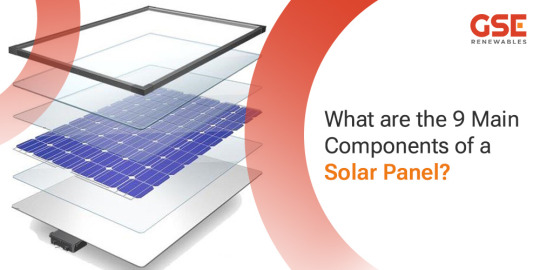
A conventional components of solar panels, including a layer of silicon cells, a sturdy metal frame, a protective glass enclosure, and a network of interconnected wiring that facilitates the smooth flow of electric current generated by the silicon cells. Silicon, despite being a nonmetallic element, possesses remarkable conductive properties, allowing it to capture and convert sunlight into electrical energy. This remarkable phenomenon is attributed to the “photovoltaic effect,” which serves as the fundamental principle underpinning solar panel technology.
In essence, when sunlight strikes a silicon cell, it triggers the movement of electrons within the cell, setting in motion an electric current. This process enables the solar panel to harness the sun’s radiant energy and transform it into a readily usable form of electricity. Remarkably, this energy generation continues as long as the sun is shining, making solar panels a dependable and sustainable source of power. Furthermore, even on overcast days when sunlight is diffused by cloud cover, solar panels are still capable of generating electricity, thanks to the sun’s persistent ability to penetrate the cloud layers. A few years ago, coal, wood, and biomass were the primary sources of energy, while renewable energy played a secondary role. However, today, renewable energy sources such as solar energy, hydroelectric power, and wind power have replaced traditional sources. Solar energy, in particular, stands out as a cost-free and environmentally friendly energy source harnessed from sunlight. Solar photovoltaic (PV) modules, commonly known as solar panels, play a pivotal role in converting sunlight into electricity during daylight hours. In this comprehensive article, we will delve into the solar panel parts and components. In a subsequent piece, we will explore the installation process of solar panels.
Solar Panel Parts And Components
A solar PV module, or solar panel, is a complex assembly comprising nine essential components of solar panels, each of which plays a crucial role. Let’s explore these components one by one:
Solar Cells: At the core of every solar panel lie solar cells, which serve as the fundamental building blocks. Thousands of these cells are meticulously connected to form a solar panel. The assembly process involves soldering, encapsulation, mounting on a sturdy metal frame, and thorough testing. The efficiency of a solar panel is directly linked to the efficiency of its solar cells. Both the cost and performance of these solar cells significantly influence the overall effectiveness of the panel. Notably, solar cell efficiencies have steadily improved over the past decade. Various materials used in their production yield differing efficiencies. Even within the same technology, different companies may achieve varying conversion efficiencies. Two common types of solar cells are monocrystalline and polycrystalline solar cells.
Solar Glass: Another critical solar installation components is the solar glass, which serves as the outermost layer of the solar panel. This glass must possess both strength and reflectivity for optimal panel performance. Its primary function is to shield the solar cells from adverse weather conditions, dust, and dirt. Typically, tempered glass with a thickness ranging from 3mm to 4mm is recommended.
EVA (Ethylene Vinyl Acetate): EVA is a highly transparent plastic layer used to encapsulate the solar cells. It forms a protective, laminated coating atop the cells, holding them together securely. This material must exhibit durability and tolerance to withstand extreme temperature and humidity conditions.
Back Sheet: The back sheet, located at the rear of the panel, serves a dual purpose by providing mechanical protection and electrical insulation. It essentially serves as a protective covering.
Aluminum Frame: The aluminum frame is a critical structural pv panel component that imparts strength to the solar panel. It is advisable to use a frame constructed from a strong yet lightweight solar panel raw material. The frame should be rigid and capable of withstanding harsh environmental conditions, including high winds and external forces. Typically, aluminum frames come in two varieties: silver and anodized black.
Junction Box: Positioned at the rear of the panel, the junction box serves as the central point where cables interconnect with the solar panel.
Interconnectors: Interconnectors facilitate the connection of solar panels to one another. These solar panel parts must exhibit exceptional weather resistance while enabling secure connections.
Silicon Glue: Silicon glue stands as the most commonly employed adhesive within a solar panel. Its robust bonding properties, along with resistance to chemicals, moisture, and adverse weather conditions, make it the preferred choice for affixing components. Notably, silicon is also the predominant semiconductor material.
Inverter: After the solar panels capture DC electricity, the next step is to channel it through a solar inverter. Your home’s grid and appliances operate on alternating current (AC) electricity. Consequently, the inverter plays a crucial role in transforming the DC electricity harvested from your panels into AC electricity, making it usable. There are two prevalent types of inverters: string inverters and microinverters. String inverters are typically affixed to the side of your residence, where they consolidate all the electricity generated by your solar system. On the other hand, microinverters are compact devices attached to the underside of each individual solar panel, allowing for the direct conversion of DC to AC power at the panel level. At GST, we offer both inverter systems. To determine which inverter system best suits your needs, we recommend consulting with your solar adviser for more information.
Conclusion
Investing in a solar panel system constitutes a significant financial commitment. Therefore, it is advisable to prioritize high-quality solar plant components. Most solar panels come with a 25-year warranty, underscoring the importance of assessing the quality and understanding the function of each constituent part. Prospective buyers should equip themselves with knowledge about the various solar panel parts and components involved in solar panel fabrication, their roles, and overall functionality to make informed decisions and avoid substandard components.
#Components of Solar Panels#What are the Key Components of Solar Panels?#solar panel parts and components
0 notes
Text
"But it's not reliable/it can't do base load/sometimes it overproduces!"
Grid-scale energy storage is a known problem that we are already working on. It's getting better every day. Pumped hydro is the gold standard and isn't going anywhere, but seawater desalination and hydrogen electrolysis are also very promising. We've also just recently made a huge breakthrough in flow batteries that don't rely on rare-earth metals, but use dissolved sugars of all things to make massively-scaleable chemical battery storage.
So last week was the hottest week in human record, which is a big yikes. Hearing this kind of news can really make you feel hopeless about the climate situation and I just wanted to remind people that clean energy is available and is on the rise.
Solar and wind energy is actually less costly than oil and gas in most parts of the world.
The transition to renewable energy is in progress and we can see it through and curb climate change within our lifetimes. Any argument you hear about how renewables aren’t going to cut it as an energy source is just oil and gas propaganda.
#and again#these things are only going to get better#solar and wind and wave and hydro#and yes even nuclear#at the current rate of improvement we could even end up generating enough surplus power to do active atmospheric carbon sequestration#and start *reversing* the atmospheric components of climate change
385 notes
·
View notes
Text
25 Years of Exploring the Universe with NASA's Chandra Xray Observatory
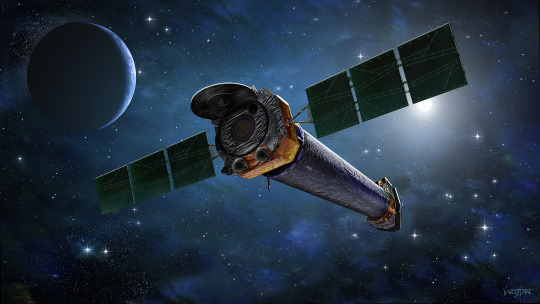
Illustration of the Chandra telescope in orbit around Earth. Credit: NASA/CXC & J. Vaughan
On July 23, 1999, the space shuttle Columbia launched into orbit carrying NASA’s Chandra X-ray Observatory. August 26 marked 25 years since Chandra released its first images.
These were the first of more than 25,000 observations Chandra has taken. This year, as NASA celebrates the 25th anniversary of this telescope and the incredible data it has provided, we’re taking a peek at some of its most memorable moments.
About the Spacecraft
The Chandra telescope system uses four specialized mirrors to observe X-ray emissions across the universe. X-rays that strike a “regular” mirror head on will be absorbed, so Chandra’s mirrors are shaped like barrels and precisely constructed. The rest of the spacecraft system provides the support structure and environment necessary for the telescope and the science instruments to work as an observatory. To provide motion to the observatory, Chandra has two different sets of thrusters. To control the temperatures of critical components, Chandra's thermal control system consists of a cooling radiator, insulators, heaters, and thermostats. Chandra's electrical power comes from its solar arrays.
Learn more about the spacecraft's components that were developed and tested at NASA’s Marshall Space Flight Center in Huntsville, Alabama. Fun fact: If the state of Colorado were as smooth as the surface of the Chandra X-ray Observatory mirrors, Pike's Peak would be less than an inch tall.

Engineers in the X-ray Calibration Facility at NASA’s Marshall Space Flight Center in Huntsville, Alabama, integrating the Chandra X-ray Observatory’s High-Resolution Camera with the mirror assembly, in this photo taken March 16, 1997. Credit: NASA
Launch
When space shuttle Columbia launched on July 23, 1999, Chandra was the heaviest and largest payload ever launched by the shuttle. Under the command of Col. Eileen Collins, Columbia lifted off the launch pad at NASA’s Kennedy Space Center in Florida. Chandra was deployed on the mission’s first day.

Reflected in the waters, space shuttle Columbia rockets into the night sky from Launch Pad 39-B on mission STS-93 from Kennedy Space Center. Credit: NASA
First Light Images
Just 34 days after launch, extraordinary first images from our Chandra X-ray Observatory were released. The image of supernova remnant Cassiopeia A traces the aftermath of a gigantic stellar explosion in such captivating detail that scientists can see evidence of what is likely the neutron star.
“We see the collision of the debris from the exploded star with the matter around it, we see shock waves rushing into interstellar space at millions of miles per hour,” said Harvey Tananbaum, founding Director of the Chandra X-ray Center at the Smithsonian Astrophysical Observatory.

Cassiopeia A is the remnant of a star that exploded about 300 years ago. The X-ray image shows an expanding shell of hot gas produced by the explosion colored in bright orange and yellows. Credit: NASA/CXC/SAO
A New Look at the Universe
NASA released 25 never-before-seen views to celebrate the telescopes 25th anniversary. This collection contains different types of objects in space and includes a new look at Cassiopeia A. Here the supernova remnant is seen with a quarter-century worth of Chandra observations (blue) plus recent views from NASA’s James Webb Space Telescope (grey and gold).
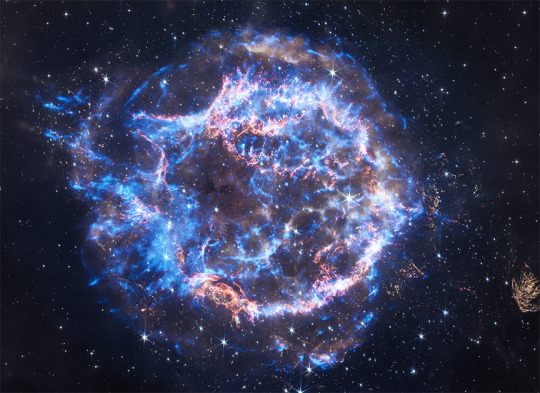
This image features deep data of the Cassiopeia A supernova, an expanding ball of matter and energy ejected from an exploding star in blues, greys and golds. The Cassiopeia A supernova remnant has been observed for over 2 million seconds since the start of Chandra’s mission in 1999 and has also recently been viewed by the James Webb Space Telescope. Credit: NASA/CXC/SAO
Can You Hear Me Now?
In 2020, experts at the Chandra X-ray Center/Smithsonian Astrophysical Observatory (SAO) and SYSTEM Sounds began the first ongoing, sustained effort at NASA to “sonify” (turn into sound) astronomical data. Data from NASA observatories such as Chandra, the Hubble Space Telescope, and the James Webb Space Telescope, has been translated into frequencies that can be heard by the human ear.
SAO Research shows that sonifications help many types of learners – especially those who are low-vision or blind -- engage with and enjoy astronomical data more.
Click to watch the “Listen to the Universe” documentary on NASA+ that explores our sonification work: Listen to the Universe | NASA+
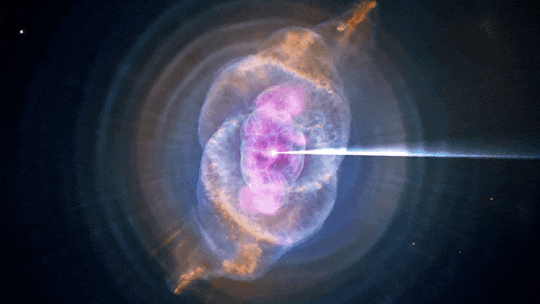
An image of the striking croissant-shaped planetary nebula called the Cat’s Eye, with data from the Chandra X-ray Observatory and Hubble Space Telescope. NASA’s Data sonification from Chandra, Hubble and/or Webb telecopes allows us to hear data of cosmic objects. Credit: NASA/CXO/SAO
Celebrate With Us!
Dedicated teams of engineers, designers, test technicians, and analysts at Marshall Space Flight Center in Huntsville, Alabama, are celebrating with partners at the Chandra X-ray Center and elsewhere outside and across the agency for the 25th anniversary of the Chandra X-ray Observatory. Their hard work keeps the spacecraft flying, enabling Chandra’s ongoing studies of black holes, supernovae, dark matter, and more.
Chandra will continue its mission to deepen our understanding of the origin and evolution of the cosmos, helping all of us explore the Universe.

The Chandra Xray Observatory, the longest cargo ever carried to space aboard the space shuttle, is shown in Columbia’s payload bay. This photo of the payload bay with its doors open was taken just before Chandra was tilted upward for release and deployed on July 23, 1999. Credit: NASA
Make sure to follow us on Tumblr for your regular dose of space: http://nasa.tumblr.com
2K notes
·
View notes